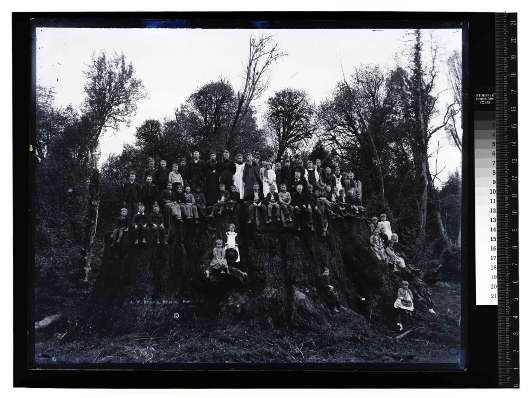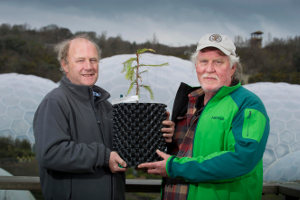UK: From California to Cornwall...4000- year- old trees to take root in the gardens at Eden
06.05.15

The Fieldbrook stump
Clones from the oldest, biggest trees in the world have arrived at the Eden Project as part of an ambitious vision to re-forest the globe.
A specially-selected batch of 100 specimens of Champion Coast Redwoods - created from living plants up to 4,000 years old – are to be reared at Eden’s nursery for planting above the world-famous Rainforest and Mediterranean Biomes.
Coast redwoods are the tallest living things and can grow to nearly 122 metres or 400 feet in height. Eden’s gardeners hope that like their forebears, the young redwoods will grow to great heights and prosper for thousands of years to come. The project is being championed by two leading environmentalists, Sir Tim Smit, Executive Vice Chairman of the Eden Project and David Milarch, Co-Founder of the Archangel Ancient Tree Archive (AATA), based in northern Michigan, USA.Sir Tim, who led the restoration of the Lost Gardens of Heligan before co-founding Eden, said: “That we now have 100 healthy cloned redwoods ready to be planted 5,000 miles from their historic forebears in California and Oregon is testament to the unique vision and skill of David Milarch and his team in working against all odds to create new life from ancient, historic trees.

Sir Tim and David Milarch with one of the saplings
“Planting saplings which could exceed the height of a 30-storey building and live for 4,000 years requires a different kind of planning. The grove of redwoods will be an amazing and lasting enhancement to our global garden here at Eden and a totem of hope for generations to come.”
David Milarch, a former biker-gang member turned world-renowned ancient tree champion, said the arrival of the trees in Europe and at Eden was an historic moment: “This will enable the formation of Europe’s first old growth redwood forest. The climate in Cornwall and at Eden is perfect for redwoods, which help fight climate change by storing vast amounts of carbon. This new plantation will be a library of the tallest, oldest living things on earth.”TheAATA’s mission is to propagate the world’s most important old growth trees before they are gone, archive the genetics of ancient trees around the world and reforest the Earth with the offspring of these trees.
The AATA team led by David Milarch is against all odds preserving the genetics of these trees, something that was thought to be impossible before Archangel spent four years on thousands of failures before eventual success.Each of the specimens that the AATA propagate is cloned from a single tree. This means that the resulting offspring are a full genetic match to the original, whereas a specimen grown from a seed will have half of the DNA of each parent.
The technique is similar to growing a cutting. Archangel sends climbers to the top of the forest giants to take cuttings from the fast-growing tips. Stumps of felled trees often put out sprouts, which can also be collected and cloned. The samples are spliced on to roots of stock saplings or dipped in hormones and bedded in peat or agar.Inspired by the success of Archangel in propagating the ancient trees, Eden is planning a UK-wide ancient tree cloning project. It will build on the great work of the Woodland Trust and Ancient Tree Forum in mapping the UK’s ancient trees. The UK has more ancient trees than the rest of northern Europe put together, with over 130,000 already mapped. Any tree over 400 years old is likely to be wild, and therefore more diverse than modern forestry selections. The project will preserve, and celebrate this precious legacy.
The batch of redwoods delivered to Eden’s nursery comprises 10 specimens each of 10 remarkable trees, including The Fieldbrook stump, the remains of a famous northern Californian redwood which was felled in 1890 when it was around 3,500 years old.
If it hadn’t been cut down it would likely be the world’s largest tree. It left a stump 35 feet in diameter, wider than any other known single trunk. Material was taken from basal shoots that grew from the stump to clone the new saplings.It is identified as the tree reputedly cut by William Waldorf Astor the American millionaire and British resident, and shipped to the UK as the clincher to win a drunken bet that he could make a table seating 40 from a single cross slice.
The slice was never made into a table, and rests in the garden of Lord Astor’s home Clivedon, now owned by the National Trust. Lord Astor later denied the story with a letter to The Times, threatening to sue anyone who repeated it. Eden has ambitions to check the veracity of the story by DNA testing the slice.For more information about the AATA go to www.ancienttreearchive.org
More information at http://youtu.be/B4IQwHw9R5c (five minutes 40 seconds in).